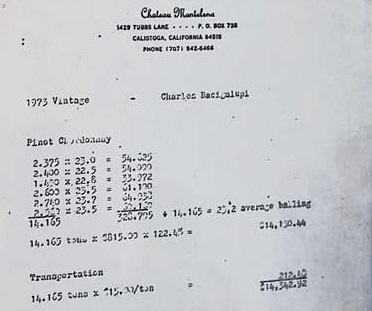The Judgement of Paris
The 1960’s was the first time Charles Bacigalupi had ever heard of Chardonnay. Bob Sisson, the University of California farm advisor for Sonoma County at that time began advising Russian River Valley growers to try planting Chardonnay. Charles obtained the budwood for the Chardonnay from Karl Wente and planted 14 acres of it in 1964.
In 1973 the Bacigalupi’s sold their Chardonnay to Chateau Montelena, a winery in Napa Valley. The winemaker at the time was Miljenko Mike Grgich. He made 1,800 cases of the 1973 Chardonnay which amounted to just over 40 tons from local growers; about 20 tons from Henry Dick in Alexander Valley, 14 tons from the Bacigalupi’s in Russian River Valley and the remaining 5 tons from Napa Valley growers John Hanna and Lee Paschich. The wine was fermented extremely slowly and spent six months in French oak barrels before bottling. The famed Paris tasting was arranged by Steven Spurrier, an Englishman who ran a wine-shop and the Académie duVin, a school for tourists and Frenchman in Paris. The wines were limited to two types, Chardonnay, the grape that made the best whites in California and France, and Cabernet Sauvignon, the grape that made the best reds in both areas. The wines tasted were transatlantic cousins, four White Burgundies against six California Pinot Chardonnays and four Grands Crus Chateaux reds from Bordeaux against six California Cabernet Sauvignons. According to it’s organizers the event was not a competitive tasting, but an opportunity to acknowledge that a young vineyard area can produce top-quality wines, given the same love, interest, skill, and money that has been lavished on European vineyards for centuries.
The American entries were all from California and were hand picked and transported to Paris.
The tasting was blind and included a panel of 9 French judges, all experts ranging from esteemed sommeliers to three star restaurant owners and well known wine journalists. Each judge was asked to evaluate the wines as to color, bouquet, palate and balance and to give each a numerical rating on a scale of 20 possible points.
The results: Chateau Montelena, 132;
Meursault Charmes, 126.5; Chalone Vineyards,
121; Spring Mountain, 104; Beaune Clos des
Mouches, 101; Freemark Abbey, 100; Batard
Montrachet 94; Puligny-Montrachet, 89;
Veedercrest Vineyards, 88; and David Bruce, 63.
The Paris tasting revolutionized the wine industry and declared that great wines could be grown in California. In his book The Judgment of Paris, George Taber, the only journalist there, documented the actual events of the famed tasting. Without this book and other media coverage the tasting might have been dismissed as a one-time fluke or publicity stunt. Instead, the Paris Tasting unquestionably changed the way the wine world looked at California wine.
The Paris Tasting Vineyard Today
The two and a half acre Paris tasting block of Chardonnay on the Bacigalupi ranch still exists today. In 2018, after two decades in contract with a Napa winery the family decided it was time to make wine from these historic vines under their own label. To honor matriarch Helen Bacigalupi and her legacy, Bacigalupi wines released a new Chardonnay from the Paris Tasting block named Renouveau. This wine is available in small quantities when released in the fall.
Read more about the Bacigalupi Vineyards part in the Judgement of Paris Tasting






1 Comment
Arctic HVAC & Construction
September 8, 2024I recently had the chance to taste the historic 1973 Chardonnay from Chateau Montelena, and it was a captivating experience. The wine is remarkably complex, showcasing a delightful balance of acidity and fruitiness. I couldn’t help but appreciate the six months spent in French oak barrels—there’s an undeniable depth to its flavor that speaks volumes about its craftsmanship. This Chardonnay is not just a peek into history; it truly stands on its own as one of the finest whites I’ve ever encountered. Every sip seemed to tell a story, echoing the passion and dedication of those involved in its creation. It’s refreshing yet sophisticated—a perfect representation of California’s potential in winemaking.